What is Photodynamic Acne Treatment: In Photodynamic acne treatment. Light energy activates photo-reactive chemicals on the surface of acne-affected skin. The activated chemical releases free oxygen radicals, killing acne-causing bacteria (p.acnes). It also causes resurfacing of the skin, removing pore plugging debris to enhance acne clearance further. A side benefit is the rejuvenation of skin and improvement of acne scars. It can even promote physiological improvements in the sebaceous glands, shrinking them so that they secrete less oil. The most common chemical agent is δ-Aminolevulinic acid (sold as Levulan in the United States). Photodynamic therapy (PDT) is an excellent intervention if you find your acne won’t go away using traditional medications. If you’ve tried everything for acne and want a safer alternative to Accutane (oral isotretinoin), light therapy for acne can be a safe, effective, and convenient alternative course of treatment for many people.
PDT can implement light-based or laser therapies that function at varying wavelengths. This enables the precise targeting of deep infections and cell blockages beneath the skin that topical medications cannot reach.
Article Update July 2022
Essential Facts to Consider for Photodynamic Acne Treatment
Photodynamic acne treatment may be effective, particularly if you have tried other treatments with no success. For the procedure, you can specific results:
- Significant acne clearing
- Combination of photodynamic acne laser treatment with other acne treatments such as topicals
- Varied results from a person to person
- Possible need for multiple treatments
Multiple treatments generally deliver significantly better results than a single treatment, and it takes time to see results.
Often, acne laser treatment is combined with other medications such as topicals to increase its effects and depending on the severity of the acne. Multiple treatments may be required.
These results can be significant, as seen in this patient result below.
How Does Light Therapy for Acne Work?
So how exactly does photodynamic acne treatment work? First, the dermatologist will prime the skin with Levulan, an aminolevulinic acid compound and photosensitizer that works with light energy. Next, a light source (typically blue light or laser light) is applied to the affected area of the skin. Activated by the light energy, the Levulan oxygenates specific molecules and creates destructive agents called free radicals. This two-part therapy breaks up blockages, kills bacteria, and initiates healthy skin peeling.
The heat from the light energy also shrinks sebaceous glands, resulting in less oil secretion. Less oil leads to reduced bacteria and decreased instances of dirt, debris, and dead skin cells stuck in pores. In essence, this physiological change to the oil glands is another mechanism by which photodynamic acne treatment stops blockages and inflammation.
PDT can be used with traditional antibiotics or as an alternative method when traditional medications fail. It is a good option for patients who are intolerant to oral isotretinoin or would like a safer alternative. Light therapy for acne [1] additionally resurfaces and rejuvenates the skin.
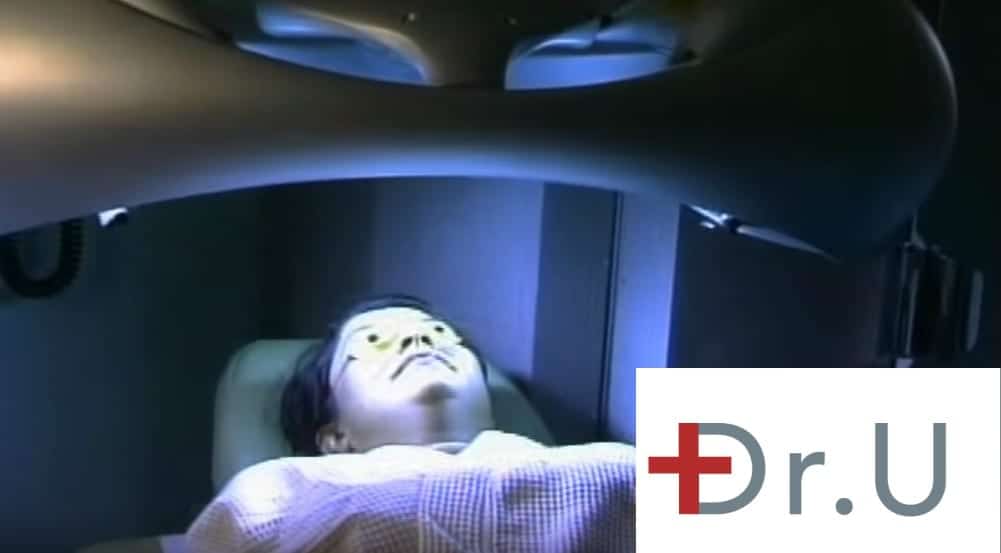
Types of Lasers and Light Therapies Used By Dr. U in Photodynamic Acne Treatment
At Dr. U Hair & Skin Clinic, Dr. Umar uses either the Vbeam or blue light for PDT. Laser or light therapy choice depends on the patient and their needs.
Vbeam Laser
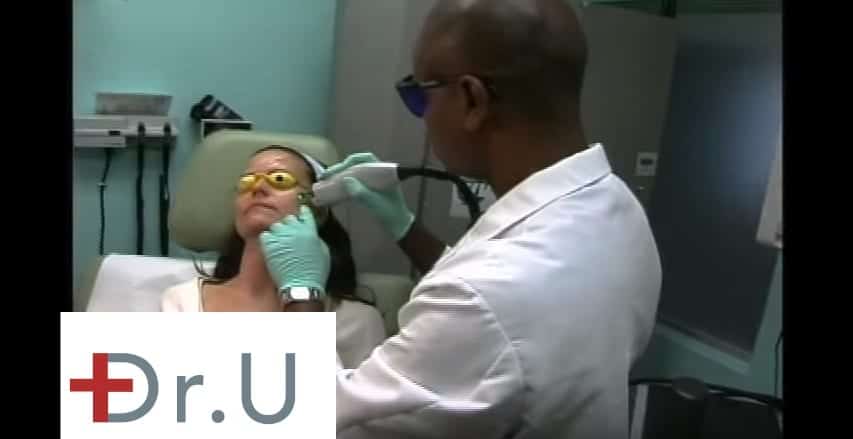
The Vbeam is a long pulse dye laser, with the V meaning “vascular.” Studies have shown that Vbeam is highly effective in photodynamic acne treatment, even for nodulocystic lesions, and is only used at monthly intervals. This makes for more timely intervention for the patient than weekly laser sessions, daily pills, and twice-daily creams. Since it is a vascular laser, it is also an ideal choice for calming skin redness that has resulted from the acne.
Advantages of pulse dye laser (VBeam) beam laser in acne PDT (Photodynamic Therapy)
- More convenient monthly treatments as opposed to weekly treatments
- Can improve acne lesion redness
- Improves acne scars
- It goes deep enough to improve cystic acne
- It offers skin resurfacing, improved texture, and more even skin tone
The disadvantages of pulse dye laser (VBeam) beam laser in photodynamic acne treatments mainly involve more discomfort than blue light acne PDT.
No Title
Go to: http://www.finetouchdermatology.com/ for more on Dr Umar’s skin and cosmetic surgery services The most effective and latest laser model from Candela, Dr. Umar uses this laser for the treatment of red spots, port-wine stains and related birthmarks, pigmented moles, rosacea, thin facial veins, spider veins, moles and scars.
Blue Light Therapy
Blue light therapy is not a laser but a type of photodynamic acne treatment that uses the blue spectrum of non-coherent light energy for Levulan activation. This light is combined with Levulan and powerfully kills p. Acnes. Blue light is a very effective light energy for stimulating the aminolevulinic acid (Levulan) and destroying targeted cells and tissues. Advantages of using blue light as an activator over laser include:
- When Blue light is used as an activator in PDT, it activates the entire Levulan treated area of the acne-affected skin uniformly, compared with V beam or other laser activators, which deliver light energy in defined spot sizes. In these events, only the treated spots are effectively treated. For this reason, blue light is preferred in precancerous conditions where uniform coverage to account for unseen lesions is critical.
- It is relatively pain-free.
Disadvantages include:
- weekly treatments as opposed to Monthly treatment with VBeam
- It does not go deep enough to treat cystic lesions. Vbeam is more effective for this reason.
- It does not address redness
- It does not address scars as effectively as VBeam
Watch this video for an example of a blue light therapy treatment session.
Acne Removal Acne Scars, Photodynamic light therapy of Acne By Dr Sanusi Umar
http://www.finetouchdermatology.com/ Photodynamic light therapy of Acne By Dr Sanusi Umar of Acne Treatment, Acne Removal, Acne Scar Removal
How Do I Know When to See a Doctor for Acne?
Any person wondering how to get rid of acne should visit a dermatologist for acne. In these instances, the problem is likely genetic, hormonal, or both. How your pimples manifest will tell you what type of acne you have and how best to treat the condition.
Contact Dr. U Hair & Skin Clinic for a free consultation if you’re uncertain how to resolve your acne.
Types of Acne that Can Be Cured With Acne Photodynamic Treatment
While acne can stem from various root causes, photodynamic acne treatment is effective for any stubborn pimples that won’t go away.
Hormonal and Cystic Acne Caused By Genetics
The most malignant type of acne is genetic. One form is hormonal, which manifests as sudden breakouts along the jawline, chin, and lower face. This is caused by cyclical fluctuations in hormone levels, producing inflammatory papules and small red bumps from bacteria.
In the worst cases, hormonal outbreaks can create painful cystic acne that is difficult to treat.
In hormonal and cystic breakouts, the condition can benefit immensely from medical intervention through photodynamic acne treatment (Acne PDT) as a safe and effective method.
Whiteheads and Blackheads – Stubborn But Less Severe Acne Types
In the minor, severe instances, acne is simply a manifestation of blocked pores due to a buildup of oil, dirt, and even skin cells; these are whiteheads and blackheads (oxidized buildup).
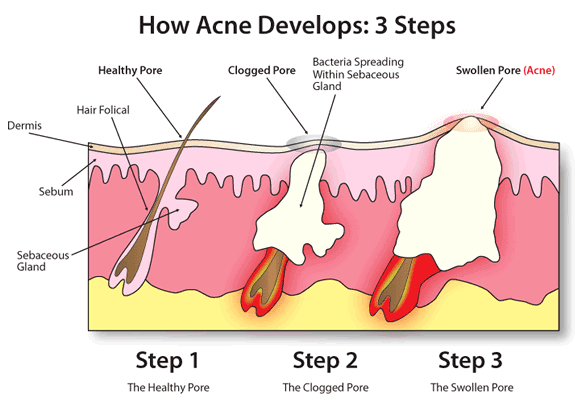
Manhattan Beach, Los Angeles Patient Results with Photodynamic Acne Treatment:
The below patient tried everything for acne but continued to struggle with severe nodulocystic lesions. His parents wanted him to pursue a safer alternative to Accutane and found light therapy for acne had worked well in other people.
They presented to Dr. U Hair & Skin Clinic, where Dr. Umar treated him with photodynamic acne using topical Levulan [2] and the Vbeam laser. Dr. U followed up this monthly regimen with Fraxel Dual laser treatments to address the patient’s acne scarring. Six weeks after his final session with Fraxel Dual, the patient no longer has those stubborn pimples that won’t disappear.
Before Dr. U’s Light Therapy for Acne:
Before presenting to Dr. Umar, oral antibiotics and creams had failed to resolve the patient’s cystic acne condition. His combination of genetics and hormones led to overactive oil glands, triggering inflammation around trapped debris and bacteria. These breakouts are common in teenagers; they’re typically uncontrollable and cause severe acne that won’t go away.
For this patient’s course of photodynamic acne treatment, Dr. Umar applied a monthly regimen of topical Levulan with Vbeam laser sessions.
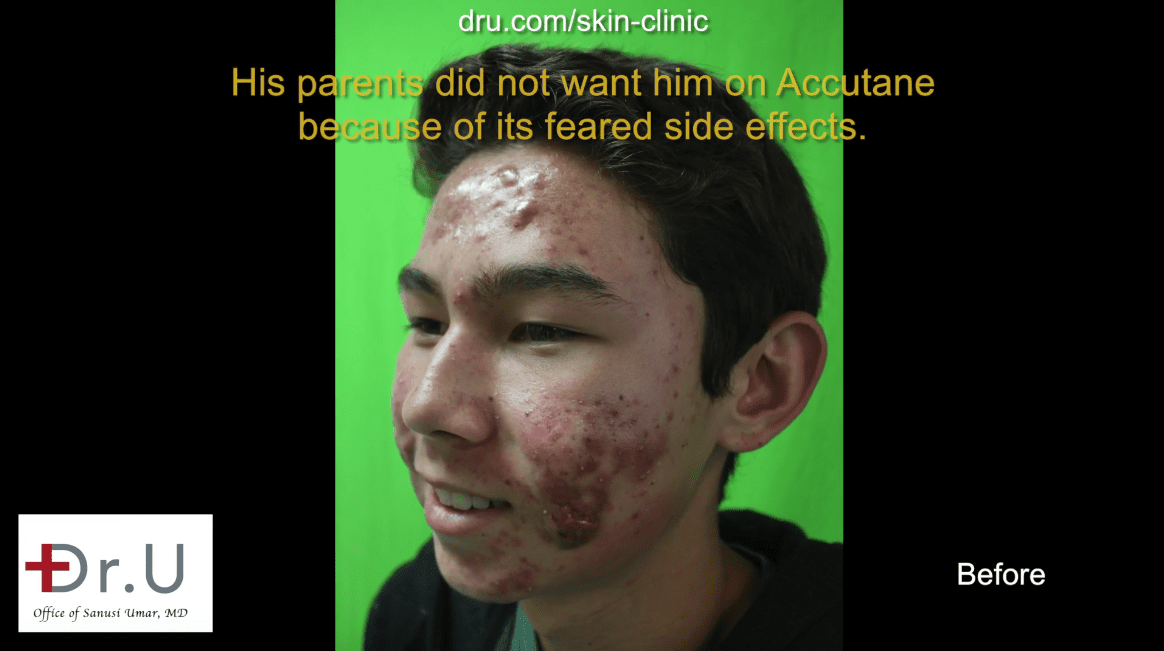
After Light Therapy for Acne:
Having tried everything for acne, this patient wasn’t sure what to expect after photodynamic therapy. Using PDT acne therapy for acne in his case proved a more effective treatment than any other medication previously attempted and a safer alternative to Accutane. (Anyone wondering about photodynamic therapy versus Accutane, patient safety and long-term happiness should be the primary consideration. Accutane should be a last resort.)
For this patient, having acne that won’t go away is no longer a concern. Six weeks after the final Fraxel session to treat his scars, he is happy and confident with the dramatic improvement. He feels free to hang out with his friends more often and enjoys the sport of track without feeling self-conscious about his skin.
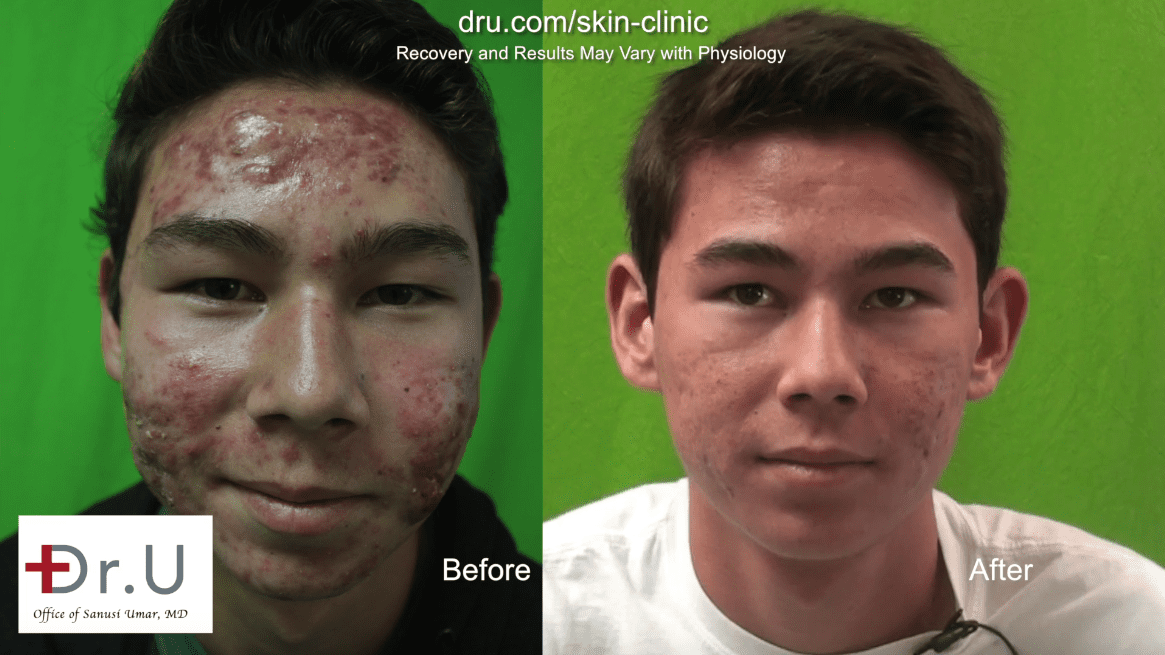
Video of Light Therapy for Acne for Manhattan Beach, Los Angeles Patient
Watch the remarkable result of this patient’s experience with photodynamic acne treatment.
Teen’s Life Changing Laser Treatment For Nodulocystic Acne
This patient suffered from nodulocystic acne. Although his condition seemed quite severe, he was able to achieve significant improvements through a combination of photodynamic and laser treatments. Watch this video to learn more about his experience.
If you live in the Manhattan Beach, Los Angeles area and want to learn more about photodynamic acne treatment for your condition, click the button below to schedule a complimentary consultation.
Frequently Asked Questions – Photodynamic Acne Treatment
Can photodynamic acne treatment damage my skin?
Photodynamic acne treatment is typically considered safe and effective for all skin types, but this depends on the type of laser used. For instance, Dr. Umar used the Vbeam laser for the above case; however, in patients with darker skin tones, Dr. U may use alternative light sources better suited for the presenting skin tone. Be sure the dermatologist you use has proven results with patients whose skin is similar to yours. Using the correct laser should not cause long-term damage and should cause rejuvenating effects, such as improvements in skin tone, fine lines, and pore size.
How do I know what to expect after photodynamic therapy?
Every patient is different and therefore responds differently to light therapy for acne. Additionally, the type of laser and heat setting varies from patient to patient, depending on the severity of the acne, skin tone, and other medications being used at the time of treatment. Patients can expect anything from light and blotchiness to extreme swelling, redness, pain, and peeling. Most of these side-effects should subside within 24-48 hours but can take up to two weeks to resolve in extreme cases. The reason for sustained inflammation is the continued activation of Levulan by the light energy from the sun and other familiar light sources. Therefore, side effects would be minimized by:
- Thoroughly wash the face off of Levulan after treatments
- Sun protection and avoidance after treatment
- Avoid direct contact of the treated area with other artificial light sources (e.g., table lamps, fluorescent lights, etc.)
- Avoiding using other photosensitizing medications
My acne won’t go away, and I also struggle with rosacea. Can light therapy for acne cure both?
Yes! PDT using Vbeam laser is an effective treatment for several vascular skin conditions and severe acne. Dr. U would enlist this laser therapy to treat rosacea, sun damage, wrinkles, and uneven pigment. If you struggle with both acne and rosacea, photodynamic acne treatment can be used to target both conditions.
Have more questions about photodynamic acne treatment? Use the button below to ask Dr. U.
Further Reading:
- Learn more about the different types of treatment for acne, including various laser therapies.
- Read an in-depth overview of all things photodynamic therapy from MedicineNet.
References:
- Acne. Wikipedia. https://en.wikipedia.org/wiki/Acne. Published July 19, 2022. Accessed July 20, 2022.
- You are being redirected… https://dru.com/acne-scar-removal-services/ and accessed July 20, 2022.
